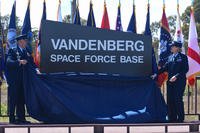The Coast Guard’s roots in America’s maritime history is a daily reminder to Coast Guard men and women of their service’s unique contributions to the nation. Arguably, nowhere is that more true than aboard Coast Guard Barque Eagle.
Crewmembers aboard the current Eagle had a unique opportunity to reflect on the service’s storied past when they visited the site of an intense battle fought by their maritime forefathers nearly 200 years before.
Present-day crewmembers aboard Eagle formed on the ship’s teak deck and stood in silence as Capt. Wes Pulver, Eagle’s commanding officer, recounted the battle that took place in the same water and the nearby bluff 198 years earlier.
“I’m constantly reminded what an immense honor it is to serve as the commanding officer of Coast Guard Barque Eagle, and this ceremony was an excellent example of that,” Pulver said. “The battle at Friar’s Head is an incredible story of persistence and fortitude, and this commemoration had a special significance to me as the present commanding officer of this great ship.”
During the formal ceremony, Pulver explained crewmembers aboard the third Revenue Cutter Eagle, during the War of 1812, were tasked with convoying merchant ships through Long Island Sound, where British men of war often pursued them. After learning of the British capture of a New Haven, Conn., merchant sloop in October 1814, Eagle’s master, Capt. Frederick Lee; his crew; and several volunteers decided to intervene.
A lack of wind forced Lee to have the Eagle towed out to sea to pursue the British warship. The following morning, Eagle’s crew found themselves dangerously close to the British brig Dispatch, a much larger and more heavily armed vessel. Eagle’s crew managed to beat back the Dispatch’s launches and they attempted to escape the warship by sailing through the shallows. The warship’s heavy guns soon forced Eagle to beach off Friar’s Head, a 160-foot-high bluff 15 miles northeast of Port Jefferson, N.Y., on the north shore of Long Island. The crew and volunteers removed Eagle’s cannons, hauled them up the bluff and began firing on the Dispatch. Local militia, already entrenched on the bluff, also commenced firing.
Three times, the crew’s flag was shot away by the British, and three times Eagle’s valiant crew returned it aloft. The battle became so desperate that Eagle’s crew ripped the pages out of their log book for wadding and used British shells lodged in the bluff as ammunition to return fire. After a day of intense combat, the Dispatch departed. Lee and his crew refloated the Eagle, but it was captured shortly thereafter on Oct. 14, 1814, when the Dispatch returned with additional British warships.
Following his speech and the presentation of the Coast Guard’s anthem “Semper Paratus,” Pulver saluted the bluff just off the port side of Eagle on behalf of the crew as Eagle’s cannons fired a 21-gun salute.
Coast Guard officer candidate Kahi Kaaua said as he stood at attention and listened to the cannons firing, he couldn’t help but think about what the 1814 crew of Eagle must have been going through, mentally and physically, during the battle. Despite his 11 and a half years as an enlisted member of the Coast Guard and tours in Afghanistan and Bahrain, Kaaua said he felt honored to be included in the commemoration.
“I’m thankful I was present to pay tribute to the brave sailors who fought for the Eagle and their country,” Kaaua said. “They set the bar, and as an officer, that’s the bar I’ll strive to reach.”
“We’re a maritime nation and reflecting on our past and celebrating those who paved the way ahead for us is who we are as a service,” Pulver said. “It’s an amazing thing to consider that the exact location we were at that very moment is the same place where our predecessors 198 years ago went into battle to defend the rights we have today.
“Its stories such as this one that make me and the crew feel so privileged and humbled to call the Eagle our own.”
























